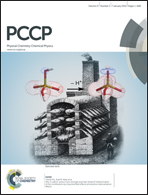A DFT approach to the charge transport related properties in columnar stacked π-conjugated N-heterocycle cores including electron donor and acceptor units†
Abstract
We present a density functional theory (DFT) study on charge-transport related properties in a series of discotic systems based on 1,3,5-triazine and tris[1,2,4]triazolo[1,3,5]triazine central cores as electron acceptor units, and phenyl-thiophene and N-carbazolyl-thiophene segments as electron donor units. The presence of both electron donor and acceptor moieties in the π-conjugated core could lead to new discotic liquid crystal (DLC) materials which are predicted to display ambipolar charge transport behavior in such a way that electrons could move through the central part of the next cores while holes mainly do through the peripheral groups. A significant increase in hole mobility when N-carbazolyl is present as an electron donor unit in the peripheral region is predicted. In addition, a detailed topological analysis of the electron charge density within the framework provided by Quantum Theory of Atoms in Molecules (QTAIM) has been performed in order to characterize intra- and intermolecular interactions in terms of hydrogen bonds and/or π⋯π stacking which contribute to the stabilization of the columnar stack and the helical self-assembly at the molecular scale.


 Please wait while we load your content...
Please wait while we load your content...